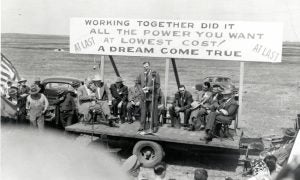Rural electric cooperatives in Ohio
Rural electric cooperatives are non-profit electric utilities. Unlike the big investor-owned utilities, rural electric cooperatives (also called “electric co-ops”) are owned by member-owners, the customers whose electricity they provide.
Ohio’s rural electric co-ops
Ohio is home to 24 rural electric cooperatives. Electric cooperatives have been in Ohio since 1936, when the Farm Bureau and Rural Electrification Administration first established early cooperatives. Since 1959, the co-ops have received their power from Buckeye Power headquartered in Cassopolis, Michigan. Today, more than 400,000 Ohio homes and businesses get their electricity from an electric cooperative.

Unfortunately, many cooperative members don’t know they are owners of their electric company or that they have a say in its governance. As a result, many rural electric cooperatives are controlled by insiders who favor the status quo. Too many rural electric cooperatives still heavily rely on centrally-generated coal-fired power and natural gas peaker plants. They see distributed renewable energy as a threat to their customer base, rather than an opportunity for their members.
This is changing. In 2016, Buckeye Power cooperative launched OurSolar, a solar leasing program. Consumers can subscribe to panels located at their local co-operative headquarters. Twenty-three arrays are planned. The total solar installed and owned by the cooperatives will amount to 2.1 MW upon completion. Critics have argued that the subscription model in the OurSolar program will cost consumers more than if they had installed solar on their own property.

Ohio resources
- OurSolar initiative – Through this initiative of the Mid-Ohio Energy Cooperative, individual customers “subscribe” to solar panels owned by cooperative.
- Findlay City Council urges utilities to play nice – This article from The Courier details an emerging dispute between AEP and the local Hancock-Wood Electric Cooperative over customer swapping.
- Ohio Rural Electric Cooperatives – Learn how to get involved in your rural electric cooperative and how to push for more solar in your co-op territory. OREC also tracks the amount of solar electricity generated through the GoSolar initiative.
- Local electric cooperative goes solar – This article from the Bellefontaine Examiner details the Logan County Electric Cooperative’s decision to install a 50 kW solar array as part of the OurSolar initiative.
